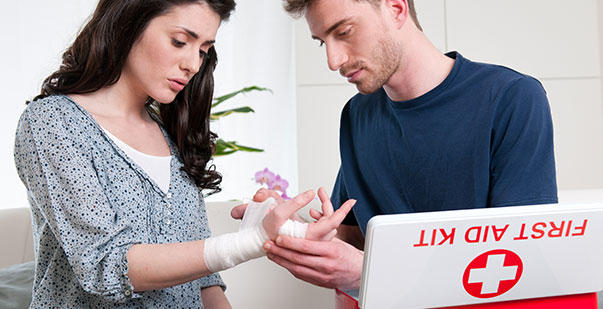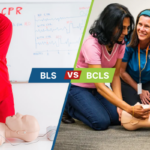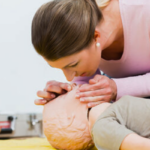
- Last Updated On: December 19, 2023
The Main Objectives and Goals of First Aid Training
In the realm of emergency response, first aid training acts as a beacon of preparedness and ensures effective intervention. Did you know that early initiation of CPR improves the chances of survival? First aid training is a valuable and life-saving course. By helping to prevent the situation from getting any worse, its goal is to preserve life and prevent the escalation of illness and injury. Let us explore the fundamental objectives of first aid training and preserve life and well-being.
In what ways does first-aid training prioritize injury prevention?
First aid purpose is not limited to immediate response; rather, it is very significant because it empowers people with the ability to recognize and prevent injuries. Here are key ways in which first-aid training prioritizes injury prevention:
- Risk Identification: The study helps trainees learn common factors that may cause injury in different settings by identifying potential hazards. A proactive attitude helps prepare for risks before emergencies happen.
- Preventive Measures: Practical skills required in first aid include barriers and secure environments that minimize accident chances. This makes people more than merely responders to creating a safe environment; they are also preventative agents for their security.
- Prevention of illness or injury from escalating: First aid training helps you learn how to contain wounds and attend to injuries. This helps prevent the further spread of damage. If a patient is bleeding profusely, it is the goal of the first aider to stop the bleeding until professional medical care arrives.
- Promotes recovery: Recovery promotion comprises employing a first aid kit to assist the person in need. This includes cleaning, cleansing, and bandaging a wound. You can also use an antibiotic ointment to improve healing in some circumstances.
- Community Impact: The first aid training promotes sharing of information, thus having an impact on injury prevention in the community. First aid training ensures personal preparedness and also well-being of the community.
What are the goals of first aid training?
First aid training focuses on the fundamental skills and knowledge that would enable you to act promptly under emergency conditions. It seeks to enable people to analyze scenarios quickly, avoid more damage, and start immediate medical backup. The five main goals of first aid training include the following:
- Rapid Assessment: The trainees learn to quickly make a scene survey and differentiate between minor and life-threatening injuries that need immediate treatment. This helps responders take fast but calculated actions in critical situations.
- Summoning Professional Help: People learn how to call for a doctor as soon as possible, determining serious circumstances when this service’s help is critical. The first aim of immediate first aid is to ensure a smooth transition to an advanced level of medical care, where necessary.
- Providing Immediate Care: The first aid training helps offer immediate care until medical assistance is sought. The objective emphasizes the significance of prompt action, which entails saving lives and lessening damage.
- Protecting the Unconscious: Protecting an unconscious person entails securely transporting them from a harmful situation, such as a fire or a busy road, to a safer location nearby. Participants in first aid training learn how to position an unconscious person so that breathing passages are not impeded.
- Promoting Competence and Confidence: Hands-on training and simulations make people confident and competent enough to take action amidst emergencies. This goal motivates responders by ensuring they are confident enough to do something constructive when responding to unanticipated medical incidents.
The aim of first aid thus is to extend help and preserve life. Participants learn to secure the safety of the victims and those around.
Read More: https://cprcare.com/should-first-aid-be-a-part-of-high-school-curriculum/
Does first-aid training prioritize rapid assessment?
Rapid assessment is critical because it helps with effective interventions. The first aid training deliberately highlights the need for rapid assessment and ascertains its importance while responding to emergencies. Here is how first-aid training prioritizes rapid assessment:
- Immediate Scene Evaluation: First aid training emphasizes the need to survey the scene quickly to ensure patient’s safety but also that of the rescuer. The instant evaluation identifies risks, allowing responders to take wise actions before assisting victims in an emergency.
- Prioritizing critical interventions: Trainees learn ways to quickly pinpoint critical issues necessitating treatment that have the potential to result in death if left unattended. This ability means that the most important actions, like initiating CPR and managing life-threatening bleeding, go first to improve the patient’s outcome.
- Assessment Adaptability: First aid training teaches adaptable assessment skills, enabling individuals to promptly assess and then reassess the changing situation. Adaptiveness is essential, especially in changing scenes, when a responder should re-engineer their strategy according to the developments.
Conclusion
These five primary objectives and goals of first aid training encompass a systematic approach to effective emergency management. The goals of first aid are to empower people to act swiftly, wisely, and on time when it matters most. Therefore, first aid training not only teaches rescuers lifesaving skills but also promotes safety consciousness, thereby equipping society for emergencies.






